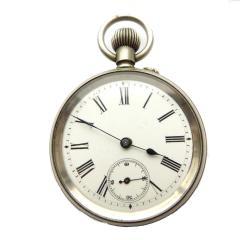Fitting a pocket watch crystal - which tool
-
Recently Browsing
- No registered users viewing this page.
-
Topics
-
Posts
-
The part was how it fell out of the movement - the train wheel bridge wasn’t screwed in. I’ll probably dismantle the part, if I can, to work it out. The train of wheels ran fine - it was only once the keyless works were installed I noticed the problem.
-
By mthomas828 · Posted
Hello, I am about 5 months into watchmaking and I love it! The attention to precise detail is what really attracts me to it. (and the tools!) I am working on a 16 jewel 43mm pocket watch movement. There are no markings besides a serial number (122248) . The balance staff needs replacement. The roller side pivot broke off. I successfully removed the hairspring using Bergeon 5430's. I successfully removed the roller using Bergeon 2810. Did i mention I love the tools?! I removed the staff from the balance wheel using a vintage K&D staff removal tool with my Bergeon 15285 (that's the one that comes with a micrometer adjustment so it can be used as a jewel press as well as a traditional staking tool...it's sooooo cool...sorry.. can you tell i love the tools?) No more digressing.. I measured the damaged staff in all the relevant areas but I have to estimate on some because one of the pivots is missing. A = Full length A= 4.80mm (that's without the one pivot...if you assume that the missing pivot is the same length as the other pivot (I'm sure it's not) then A = 5.12 mm...(can I assume 5.00mm here?) F= Hair spring collet seat F= .89mm (safe to assume .90 here? .. I am sure that my measurement's would at least contain .01 mm error ?) G = balance wheel seat G = 1.23 mm (1.20mm?) H = roller staff H = .59mm (.60 mm?) B = bottom of the wheel to roller pivot B = 2.97mm (3.00 mm?) here I am estimating again because this pivot is missing. So my friends, and I thank you profusely, can you point me in the right direction as to how to proceed? Do i buy individual staffs? or an assortment? Since I don't know exactly the name of the manufacturer, will that be a fatal hindrance? Tbh, I'm not even sure what country of origin this movement is. Thank you! -
By Neverenoughwatches · Posted
Thats why i asked that question earlier, what happens if lubrication is placed directly on top of epilame ? As opposed to walled within its non epilamed area . I'm not saying its right, i have no idea , just asking questions. -
thinking of where epilam should be removed did you know there was a patent that covers this? At least for the escapement I'm attaching it. GB1057607A-1 epilame.pdf
-
By LittleWatchShop · Posted
Back home...printing now. Will report results
-







Recommended Posts
Join the conversation
You can post now and register later. If you have an account, sign in now to post with your account.
Note: Your post will require moderator approval before it will be visible.